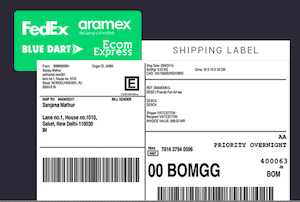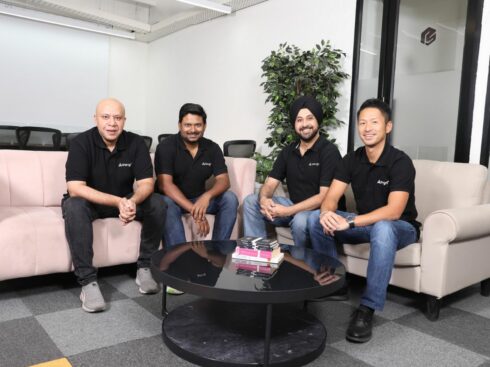The only way to do great work is to love what you do – Steve Jobs
“I loved building websites right from my seventh grade, so I simply started off with something that I knew,” begins Saahil Goel. Saahil started off his career as a management consultant for various companies in India and the US till 2011. But his heart was not in it.
“I have always been working on the tech side. The Internet was something that I was passionate about, but I was never doing it as a profession. However, having seen SMB site enablers like Shopify in the US, and the open opportunity in India and combining that with my love for building websites, I just stepped into it.”
Like Jobs said, when passion meets excellence, nothing could stop you in the entrepreneurial world. And that’s what happened with Saahil, the eventual co-founder of DIY ecommerce platform KartRocket.
When KartRocket set the ball rolling in 2012 in Delhi, there was almost no other company trying to capitalise on the over 46.7 Mn SME base of India. “At that time in the US, Shopify, was working as the SMB site enabler. But in India there were not many players. Although Martjack existed, everybody else was majorly into web development and nobody was actually going towards the seller market as such,” recalls Saahil.
Now after four years of inception, the company has grown from a 3,000 initial seller base to a bouquet of 50,000 sellers, across all of Kartrocket offerings which includes – the primary company KartRocket, a B2B ecommerce SaaS service provider; ShipRocket, a B2C logistics service provider; and Kraftly, a- C2C mobile marketplace for flea market sellers.
The company has also added more than $8 Mn funds to its name, listing investors such as Bertelsmann India Investments (BII), Nirvana Digital India Fund, Nirvana Digital Investment Holding Co. Ltd., 500 StartUps, Singapore-based Beenext, Japan-based Beenos (NetPrice) and 5ideas.
The Kartrocket Story: Webstore+ Logistics+ Payments
 Kartrocket began as a simple SMB enabler for Indian enterprises, like the established ones in the US. Saahil was joined in this endeavour by his childhood friend Gautam Kapoor who was, at that time, running his family business and was heavily into logistics and supply chain management. They spent the first six months just understanding the market that existed in India. And one thing the duo realised was that, unlike the US, Indian retailers do not like to work with 10 different vendors when it comes to going online.
Kartrocket began as a simple SMB enabler for Indian enterprises, like the established ones in the US. Saahil was joined in this endeavour by his childhood friend Gautam Kapoor who was, at that time, running his family business and was heavily into logistics and supply chain management. They spent the first six months just understanding the market that existed in India. And one thing the duo realised was that, unlike the US, Indian retailers do not like to work with 10 different vendors when it comes to going online.
“So from day one, we pitched webstore+logistics+payments, all in one place. At that time, we were the first company, globally, which provided this combined version,” says Saahil.
With KartRocket catering to website development needs and their logistics vertical ShipRocket handling the logistics requirements of SME’s, the team got good traction, signing up 40-50 clients in the first year. It was around then when they met Vishesh Khurana, who was working as a consultant in the ecommerce domain. “He first approached us with a couple of clients, who wanted to build their websites. So, he was almost the sales channel for us. Later, we persuaded him to come onboard, and he became the third leg of the company in late 2012,” says Saahil.
The company remained bootstrapped for a good one-and-a-half year. But because of the client base, by the time it raised the first round, from Pearl Uppal and Gaurav Kachru’s 5ideas startup fund, it was already breaking even. As Saahil recalls,
“We were actually not looking to raise money that time. We wanted to reach 200-300 merchants, get a decent revenue run rate and then raise funds at a better valuation. We just approached Pearl Uppal to build a website for her boutique, not even aware that she runs a startup fund.”
However, after meeting with Pearl Uppal and Gaurav Kachru, the duo soon realised that having the right mentors at the early phase, would not only allow them to really learn how to build the product, but also how to strategise and raise more funds in the future.
With the fundamentals already in place, the company next forayed into the C2C segment in September 2015, with its mobile marketplace Kraftly – to tap the large seller base comprising homepreneurs, local artisans and flea market sellers.
“On our part, nothing was planned from day one. We go as the market goes and we believe that eventually sellers in a country like India, would need the right ecosystem, right tools, and right services. The way ecommerce is explored, the sellers’ side of marketplace tools will also get explored,” says Saahil.
To Use The Right Product, To Go After The Right Pillar At Any Point Of Time
KartRocket has been structured in such a way, that enables it to cater to the different needs of SMEs at various phases right from being online to deliver their products. As described by Saahil, the team works for ecommerce enablement on four pillars: catalogue/presentation of website or product; payments and logistics; discovery; and brand-building.
As he says, “Discovery is not the same as brand building because discovery and sales led to marketing usually. However, brand building is done from your own portal only. So, we have divided our services in these four parts, and then whether it’s Kartrocket, ShipRocket or Kraftly, as per the needs of client SMEs, we basically use the right product to go after the right pillar, so they are able to use one of our services at any given time.”
He further adds, “We work with all the marketplaces, logistics providers, payment companies; so we are working with everybody in the ecosystem. We are simply a layer of integration, and we help the sellers in doing things in a much easier fashion, than what they would have to do if they had to work with each vertical directly. So, that’s the kind of play we are into, right now.”
As claimed by the founders, with a team size of 200, as of now the annual GMV powered across the three products has grown by 5x in the last one year to roughly $50 Mn. ShipRocket now processes 1.5 Mn shipments a year (annualised). The company claims to have doubled its revenue in the last nine months and is on track to hit $3.5 Mn of annualised revenue by close of the financial year.
In the last one year, Kraftly has resulted into conversions of as high as 8%, on good days, with more than 50% orders from organic channels, also resulting in 35%-40% repeat buyers each month.
“Roughly 12% of our monthly users also fire up our app daily, and on average 15 times in a month. Kraftly is available on the web as well as app platforms. We have over half a million installs and roughly 2 Mn visitors on our website each month,” says Saahil.

‘We Spent The First Two Years Attracting Clients, Increasing Visibility, And Making People Aware”
“Back in 2012, a lot of people did not believe in the ecommerce story. However, there has been a shift today. Now people might still not be comfortable enough to buy online, but they know of its existence,” says Saahil.
As he mentions, two good things happened to the team in the early phase.
“First we got a lot of pure-play online retailers. These are people who are not traditional SMBs, but a young 25-30-year lot, college graduates, who had an idea to source product from one place and to only sell it online. So they made up a good 70% of our early customer base. They were just looking for a plug and play solution that they can start using immediately. So, earlier on, we were not after big retailers and companies as we knew it’s harder to convince them.”
Next, it was adopted by Amazon as a logistics service for its merchants
on board. “Amazon was just piloting in India that time and, early on, didn’t have any logistics capabilities. Since we were already on the ground for one year by then with a good logistics solution, we got picked. So they passed on a lot of merchants to us in our second year of operation,” says Saahil. “ Also, it gave us good visibility and branding as people started searching in a sense, ‘Yaar ye kaunsi company hai jise Amazon refer kar rahi hai’,” he chuckles, reminiscing.
Eventually, as he describes, the team also made a lot of effort in putting up content on the website on the usual issues faced by the sellers back then – such as how to write product descriptions, how to do basic SEO, etc. “It was kind of a small sellers guidebook almost, and was something we were developing constantly, and trying to attract the right kind of people who were looking for it. So, the first two years went in doing just that – attracting people, increasing visibility, and making people aware,” says Saahil.
“Yes! There Is Lots Of Competition”
Saahil admits that there lies a lot of competition and the sector is already crowded with many players. While for KartRocket there are opponents such as Martjack, BuildaBazaar, Shopnix, etc., Kraftly tussles with C2C marketplaces like Shopo and Paytm.
Saahil further describes the competition as, “For Kraftly, we have offline kiosks and exhibitions as huge competition. This system of putting up stalls is already in place and already has preconceived notions that, ‘Boss, yahan to saaman bikega hi.’ However, things are changing now. People understand that they should be present there (offline kiosks), but they should also be present here (online),” he says.
Saahil further believes that pretty much every marketplace is some sort of competition as well. As he explains,
“The sellers have a choice. Not every seller wants to go after building a brand. For example, if I am a mobile phone distributor, I could care less about getting a brand. I only care about selling my stock. So, we go after unstructured, or private label categories, because the rest don’t have any reason to build their brand. So, that is a bit of a competition for us as we can’t go after that market as they are anyway happier selling at marketplaces.”
He further adds that the biggest competition is from existing web development companies. “We have seen the times when sellers struggled between whether to give KartRocket INR 3000/month to execute ecommerce on their website or ask their existing website developer to turn on the shopping part for the displayed products just for a few more bucks,” says Saahil. However, he believes that people are now realising that running an ecommerce site is not the same as running a regular version of a website, as it not only includes shopping but also integrates payments, logistics, optimisation and more. So, now people make that comparison.
Also, a lot of sellers who sell successfully on marketplaces, they also care less about rolling out their own websites. Despite putting in around 25%-30% commission, they are happy to sell on marketplaces and seldom thought of pushing for their own websites. So, that is another area which the founders cannot go after.
All said and done, Saahil ultimately believes that there is no single major competitor to the company. As he says, “As we are (deep) into the ecosystem, competition comes from all directions. So, there is no single, direct competitor for us. Depending upon which segment you are talking, anybody can be our competition.”
“FOMO Has Become A Big (Concern) Now”
SME/ MSME is one section that has gained widespread attention from all the sectors, be it industry or government or consumers, in the past few years. As Saahil says, the biggest change the team has seen in the SME ecosystem of India is awareness.
“Earlier, 80% of our sales pitch had: ‘Why you should go online’ and the last 20% was: ‘Why you should use us?’ Now, we don’t have to tell anyone why we need to go online. People now are evaluating on premises of ‘Why they should choose us’. So, that has really changed our world to a great extent,” he adds.
He also believes that with the majority of consumers moving online, people in  every vertical – be it payments, logistics, or sellers – have also realised that being online is a necessity in today’s business scenario. Saahil recalls an incident during the initial three months of starting the company, supporting this verdict. “In our early days, I remember meeting with a senior official of Blue Dart, as we were looking for a contract at that time to resell their services to the merchants. He viewed ecommerce as just a 1%-2% market and believed it to be a temporary phase. Today, Blue Dart actually has more than 60% ecommerce businesses on its lists. So, you see, that’s the change we are talking about and with the recent demonetisation drive, I think fear of missing out has become even more apparent now.”
every vertical – be it payments, logistics, or sellers – have also realised that being online is a necessity in today’s business scenario. Saahil recalls an incident during the initial three months of starting the company, supporting this verdict. “In our early days, I remember meeting with a senior official of Blue Dart, as we were looking for a contract at that time to resell their services to the merchants. He viewed ecommerce as just a 1%-2% market and believed it to be a temporary phase. Today, Blue Dart actually has more than 60% ecommerce businesses on its lists. So, you see, that’s the change we are talking about and with the recent demonetisation drive, I think fear of missing out has become even more apparent now.”
This is why, going forward, KartRocket has laid its focus on heavy product development. As Saahil says, “We are focussing on developing technology on the product side, because as we have grown, by god’s grace, we have been able to scale the company at a point where we can focus on doing the next thing, rather than focussing on managing the current platform.”
The founders further plan to innovate their marketing tools on the mobile and discovery side, as they believe that one of the key things a SME needs is the ability to market itself.
“So in a big marketplace, you can sell, but eventually not everybody will get the part of a larger pie. So, there has to be other tools available for them. For eg. on Kraftly, we have built tools like seller WhatsApp, seller Instagram, etc. We are building more tools like that so that the sellers can themselves use them in a much easier way and be able to market their own product. Aso, we will be focussing heavily on selling and getting more sellers to work with us, because, as told earlier, we are a seller-first company,” concludes Saahil.
Editor’s Note
India has come a long way since the economic reforms of 1991. As Ajit Ranade, Chief Economist at Aditya Birla Group mentioned in one of his recent articles in Forbes Magazine, it’s time to focus on making ‘starting, running and shutting down a business’ as hassle-free as possible.
SME/MSMEs form a major pillar of India’s industrial economy. While the government and corporates like Google are doing their part in paving a way to the ‘digital,’ several entrepreneurs are busy building an entire ecosystem, to ease of things for them. While initiatives like Kraftly, Shopo, are an attempt to give small sellers a platform to showcase their products, players in the ecommerce SaaS segment like KartRocket, Shopify, Martjack etc. are playing their roles in streamlining processes to get them online.
Also, the entire brigade of ecommerce marketplaces and emerging logistics and digital payment companies in the country has created a large market for this largely fragmented industry. They have even given rise to freelancing opportunities in the country when it comes to services such as writing a product description, photoshoots for products, create banners or do creatives – in all, creating a binding ecosystem for upcoming and existing SME players to get online in a ‘bindaas’ fashion.
KartRocket has its finger in every piece of this ecosystem – but how will the company innovate and remain grounded in this extremely crowded space, only time will tell.
[Note: This article is part of The Junction Series. We will be covering the EnterpriseTech sector in detail at The Junction 2017 in Jaipur. Learn more about The Junction here!]



























